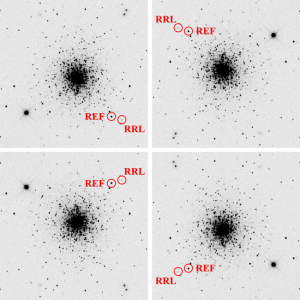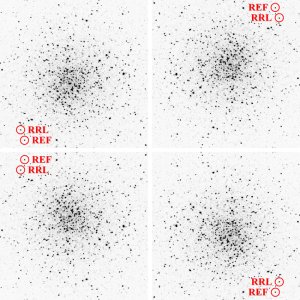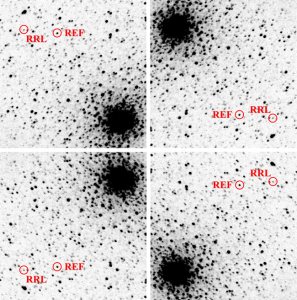Note: use a mouse instead of a trackpad or touchscreen to limit frustration while using Afterglow.
Click “Next” above to see the step-by-step instructions.
Alternate Format: Video Instructions
- Follow along with this tutorial video
Alternate Format: Written Instructions
- Open your class images. (File path included in your assignment)
- Invert the colors of the image by choosing “inverted” on the Display panel.
- Reorient your image until it matches one of the finder charts below. Orientation options are on the Display panel.
- Use the finder chart below to identify both:
- The reference star “REF”
- The RR Lyrae star “RRL” — this is the variable star
- Finder Charts:
- Semester: Northern-Hemisphere Fall (Southern-Hemisphere Spring)
Globular Cluster: NGC 1261
Reference Star’s Apparent Magnitude: 13.87
(enlarge)
Semester: Northern-Hemisphere Spring (Southern-Hemisphere Fall)
Globular Cluster: NGC 3201
Reference Star’s Apparent Magnitude: 13.60
(enlarge)
Semester: Northern-Hemisphere Summer (Southern-Hemisphere Winter)
Globular Cluster: M28
Reference Star’s Apparent Magnitude: 12.98
(enlarge)
- The finder chart includes four—but not all—possible flips and rotations that you may encounter. You may still have to flip or rotate your image to match it up with one of these four possibilities.
- Semester: Northern-Hemisphere Fall (Southern-Hemisphere Spring)
- Mark the stars
- Choose the Markers icon on the right, as in Label Moons (and Objects)
- Choose “Centroid clicks”
- Click on the REF star, then click again to label it “REF”
- Click on the RRL star, then click again to label it “RRL”
- Download your marked image and insert it into your assignment.
Media Attributions
- Image invert and reorient
- 5-il-001-revis-a
- 5-il-001-revis-b
- 5-il-001-revis-c

